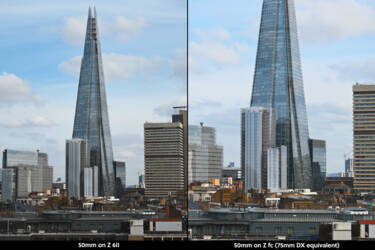What is crop factor and how do I calculate it? DX and FX explained

How does sensor sizes affect me? Everything you need to know
When digital cameras first emerged, manufacturers opted to make image sensors smaller and more affordable than the traditional 35mm film frame. This technological shift necessitated a way to describe how a camera’s sensor size impacted the angle of view and field of view compared to 35mm photography. Thus, the concept of crop factor was born.
What is crop factor?
Crop factor, also known as focal length multiplier, refers to the ratio between the size of a camera’s image sensor and the size of a 35mm full-frame sensor (36mm x 24mm). It indicates how much of the scene a particular lens can effectively capture on that given sensor size.
Nikon’s full-frame FX cameras are identical to 35mm film, giving them a 1.0x crop factor with no multiplier effect. In contrast, Nikon’s line-up of DX cameras features APS-C sized sensors measuring approximately 24mm x 16mm. To calculate the exact crop factor, you’ll need to divide the diagonal measurement of a 35mm full-frame sensor (43.7mm) by the diagonal measument of your camera’s sensor size. Nikon’s DX line up has a measurement of 28.4mm.
Crop factor: 43.27mm/28.4mm = 1.52x
Nikon mirrorless cameras
At time of publication, there are three DX mirrorless cameras and seven FX mirrorless cameras you can purchase.
DX cameras:
FX cameras:

The left image has been taken on the Nikon Z 6II with the NIKKOR Z 24-70mm f/2.8 S with a focal length of 50mm. The right uses the Nikon Z fc with the NIKKOR Z DX 16-50mm f/3.5-6.3 VR at focal length 50mm. The right image appears cropped in because it has the DX equivalent crop of 75mm (50mm x 1.5 = 75mm).
Crop factor vs focal length
Crop factor itself doesn’t physically alter the optical characteristics or design of a lens. Instead, it determines the effective field of view and angle of view you’ll achieve when using that lens on a particular sensor size.
For example, if you mount a NIKKOR Z 50mm f/1.8 S on a Nikon DX body with a 1.5x crop factor, you’ll get an angle of view equivalent to using a 75mm lens (50mm x 1.5x) on a full-frame FX camera. This is because the smaller DX sensor is only capturing and recording a tighter area in the middle of the image circle projected by that 50mm lens.
Calculation examples:
NIKKOR Z 24-70mm f/2.8 S on a Nikon Z fc (DX)
Overall equivalent range 36-105mm (24 x 1.5 = 36mm, 70 x 1.5 = 105)
NIKKOR Z DX 16-50mm f/3.5-6.3 VR on a Nikon Z fc (DX)
Overall equivalent range 24-75mm (16 x 1.5 = 24mm, 50 x 1.5 = 75)
NIKKOR Z 14-24mm f/2.8 S at 24mm focal length on a Nikon Z 8 (FX)
No crop factor change, focal length is true (14 x 1 = 14, 24 x 1 = 24)
Nikon’s current DX line-up
Nikon’s three DX mirrorless camera bodies utilise the APS-C-sized 20.9-megapixel sensors, resulting in a 1.5x crop factor when compared to full-frame sensors. The three bodies are compatible with Nikon’s line of affordable DX mirrorless lenses, as well as FX, full-frame lenses.
The Z 30 is the most affordable, focusing on vlogging and content creation needs. The Z 50 kicked off Nikon’s DX mirrorless system as an all-around performer. The Z fc provides a compelling retro design and experience.
Read more: How many lenses do I need?

The left image has been taken on the Nikon Z fc using the NIKKOR Z 24-70mm f/2.8 S at 50mm focal length (75mm DX equivalent as 50mm x 1.5 = 75mm). The right image is 50mm focal length taken on the Nikon Z 6II using the NIKKOR Z DX 16-50mm f/3.5-6.3 VR.
Why use DX?
While having a DX sensor does provide a tighter field of view compared to full-frame cameras, there are several key advantages to using Nikon’s DX format that make it an excellent choice for many photographers. The smaller size of the APS-C sensor allows for more compact and lightweight camera body designs. This improved portability can be invaluable for travel photography, hiking or any situation where minimising the overall bulk of your kit is beneficial.
Secondly, DX lenses are specifically designed to provide excellent image quality within the crop format, often at a more affordable price point compared to professional-grade FX lenses. This makes building a high-performing DX kit more accessible for enthusiasts and those on tighter budgets.
Not to mention the 1.5x crop factor can actually be advantageous in certain shooting scenarios. For disciplines such as sports, wildlife and other telephoto-biased applications where maximum reach is desired, the DX crop can provide a perception of ‘reaching’ subjects better and bringing them closer within the frame.
The crop factor can also be leveraged creatively for tighter environmental portraits and landscape photography, allowing you to capture impactful compositions using shorter focal lengths than you’d need on a full-frame body.
While understanding crop factor is crucial for selecting the ideal lenses and achieving your desired field of view, Nikon’s DX format remains an excellent choice for photographers who prioritise value, portability and versatility in their camera kit.
More in Technology and Know-how
Featured products
Discover NIKKOR lenses

For limitless creativity













